List of mammals of Laos
This is a list of the mammal species recorded in Laos. There are 178 mammal species in Laos, of which four are critically endangered, eight are endangered, twenty-three are vulnerable, and two are near threatened. One species has been described since the last IUCN assessment.[1]
The following tags are used to highlight each species' conservation status as assessed by the International Union for Conservation of Nature:
| EX | Extinct | No reasonable doubt that the last individual has died. |
| EW | Extinct in the wild | Known only to survive in captivity or as a naturalized populations well outside its previous range. |
| CR | Critically endangered | The species is in imminent risk of extinction in the wild. |
| EN | Endangered | The species is facing an extremely high risk of extinction in the wild. |
| VU | Vulnerable | The species is facing a high risk of extinction in the wild. |
| NT | Near threatened | The species does not meet any of the criteria that would categorise it as risking extinction but it is likely to do so in the future. |
| LC | Least concern | There are no current identifiable risks to the species. |
| DD | Data deficient | There is inadequate information to make an assessment of the risks to this species. |
Order: Proboscidea (elephants)
The elephants comprise three living species and are the largest living land animals.
- Family: Elephantidae (elephants)
- Genus: Elephas
- Asian elephant, E. maximus EN[2]
- Genus: Elephas
Order: Scandentia (treeshrews)
The treeshrews are small mammals native to the tropical forests of Southeast Asia. Although called treeshrews, they are not true shrews and are not all arboreal.
- Family: Tupaiidae (tree shrews)
- Genus: Tupaia
- Northern treeshrew, T. belangeri LC[3]
- Genus: Tupaia
Order: Primates
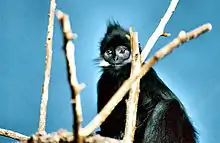
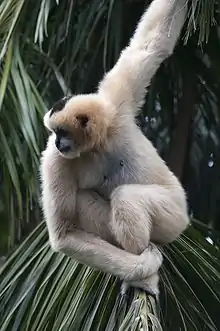
The order Primates contains humans and their closest relatives: lemurs, lorisoids, monkeys, and apes.
- Suborder: Strepsirrhini
- Infraorder: Lemuriformes
- Superfamily: Lorisoidea
- Family: Lorisidae
- Genus: Nycticebus
- Bengal slow loris, N. bengalensis EN[4]
- Sunda slow loris, N. coucang EN[5]
- Pygmy slow loris, N. pygmaeus EN[6]
- Genus: Nycticebus
- Family: Lorisidae
- Superfamily: Lorisoidea
- Infraorder: Lemuriformes
- Suborder: Haplorhini
- Infraorder: Simiiformes
- Parvorder: Catarrhini
- Superfamily: Cercopithecoidea
- Family: Cercopithecidae (Old World monkeys)
- Genus: Macaca
- Stump-tailed macaque, M. arctoides VU[7]
- Assam macaque, M. assamensis NT[8]
- Crab-eating macaque, M. fascicularis VU[9]
- Northern pigtail macaque, M. leonina VU
- Rhesus macaque, M. mulatta LC[10]
- Genus: Macaca
- Subfamily: Colobinae
- Genus: Trachypithecus
- Francois' langur, T. francoisi VU
- Germain's langur, T. germaini EN
- Laotian langur, T. laotum DD
- Annamese langur, T. margarita
- Dusky leaf monkey, T. obscurus EN[11]
- Genus: Pygathrix
- Red-shanked douc, P. nemaeus EN
- Genus: Trachypithecus
- Family: Cercopithecidae (Old World monkeys)
- Superfamily: Hominoidea
- Family: Hylobatidae (gibbons)
- Genus: Hylobates
- Lar gibbon, H. lar EN[12]
- Pileated gibbon, H. pileatus EN
- Genus: Nomascus
- Northern buffed-cheeked gibbon, N. annamensis EN
- Black crested gibbon, N. concolor CR
- Yellow-cheeked crested gibbon, N. gabriellae EN
- Northern white-cheeked gibbon, N. leucogenys CR
- Southern white-cheeked gibbon, N. siki EN
- Genus: Hylobates
- Family: Hylobatidae (gibbons)
- Superfamily: Cercopithecoidea
- Parvorder: Catarrhini
- Infraorder: Simiiformes
Order: Rodentia (rodents)
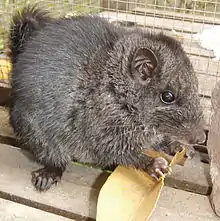

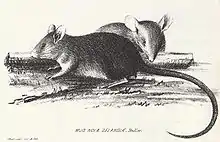
Rodents make up the largest order of mammals, with over 40% of mammalian species. They have two incisors in the upper and lower jaw which grow continually and must be kept short by gnawing. Most rodents are small though the capybara can weigh up to 45 kg (99 lb).
- Suborder: Hystricomorpha
- Family: Diatomyidae
- Genus Laonastes
- Laotian rock rat, Laonastes aenigmamus LC
- Genus Laonastes
- Family: Hystricidae (Old World porcupines)
- Genus: Atherurus
- Asiatic brush-tailed porcupine, Atherurus macrourus
- Genus: Hystrix
- Malayan porcupine, H. brachyura LC[13]
- Genus: Atherurus
- Family: Diatomyidae
- Suborder: Sciurognathi
- Family: Sciuridae (squirrels)
- Subfamily: Ratufinae
- Genus: Ratufa
- Black giant squirrel, Ratufa bicolor
- Genus: Ratufa
- Subfamily: Sciurinae
- Tribe: Pteromyini
- Genus: Biswamoyopterus
- Laotian giant flying squirrel, Biswamoyopterus laoensis
- Genus: Belomys
- Hairy-footed flying squirrel, Belomys pearsonii
- Genus: Hylopetes
- Particolored flying squirrel, Hylopetes alboniger EN
- Indochinese flying squirrel, Hylopetes phayrei
- Genus: Petaurista
- Spotted giant flying squirrel, Petaurista elegans
- Genus: Biswamoyopterus
- Tribe: Pteromyini
- Subfamily: Callosciurinae
- Genus: Callosciurus
- Finlayson's squirrel, Callosciurus finlaysonii
- Inornate squirrel, Callosciurus inornatus
- Genus: Dremomys
- Asian red-cheeked squirrel, Dremomys rufigenis
- Genus: Menetes
- Berdmore's ground squirrel, Menetes berdmorei
- Genus: Tamiops
- Himalayan striped squirrel, Tamiops macclellandi
- Maritime striped squirrel, Tamiops maritimus
- Cambodian striped squirrel, Tamiops rodolphei
- Genus: Callosciurus
- Subfamily: Ratufinae
- Family: Spalacidae
- Subfamily: Rhizomyinae
- Genus: Rhizomys
- Hoary bamboo rat, Rhizomys pruinosus
- Large bamboo rat, Rhizomys sumatrensis
- Genus: Rhizomys
- Subfamily: Rhizomyinae
- Family: Muridae (mice, rats, voles, gerbils, hamsters, etc.)
- Subfamily: Murinae
- Genus: Bandicota
- Greater bandicoot rat, Bandicota indica
- Genus: Berylmys
- Small white-toothed rat, Berylmys berdmorei
- Bower's white-toothed rat, Berylmys bowersi
- Genus: Chiromyscus
- Fea's tree rat, Chiromyscus chiropus
- Genus: Chiropodomys
- Pencil-tailed tree mouse, Chiropodomys gliroides
- Genus: Dacnomys
- Millard's rat, Dacnomys millardi
- Genus: Hapalomys
- Delacour's marmoset rat, Hapalomys delacouri
- Genus: Leopoldamys
- Edwards's long-tailed giant rat, Leopoldamys edwardsi
- Long-tailed giant rat, Leopoldamys sabanus
- Genus: Maxomys
- Mo's spiny rat, Maxomys moi
- Red spiny rat, Maxomys surifer
- Genus: Mus
- Ryukyu mouse, Mus caroli
- Fawn-colored mouse, Mus cervicolor
- Cook's mouse, Mus cookii
- Gairdner's shrewmouse, Mus pahari
- Genus: Niviventer
- Chestnut white-bellied rat, Niviventer fulvescens
- Lang Bian white-bellied rat, Niviventer langbianis
- Genus: Saxatilomys
- Pauline's limestone rat, Saxatilomys paulinae
- Genus: Rattus
- Ricefield rat, R. argentiventer LC
- Polynesian rat, R. exulans
- Lesser ricefield rat, R. losea
- Himalayan field rat, R. nitidus
- Brown rat, R. norvegicus LC introduced[14]
- Sikkim rat, R. sikkimensis VU
- Tanezumi rat, R. tanezumi
- Genus: Vandeleuria
- Asiatic long-tailed climbing mouse, Vandeleuria oleracea
- Genus: Bandicota
- Subfamily: Murinae
- Family: Sciuridae (squirrels)
Order: Lagomorpha (lagomorphs)
The lagomorphs comprise two families, Leporidae (hares and rabbits), and Ochotonidae (pikas). Though they can resemble rodents, and were classified as a superfamily in that order until the early 20th century, they have since been considered a separate order. They differ from rodents in a number of physical characteristics, such as having four incisors in the upper jaw rather than two.
- Family: Leporidae (rabbits, hares)
- Genus: Lepus
- Burmese hare, L. peguensis LC
- Genus: Nesolagus
- Annamite striped rabbit, N. timminsi LC
- Genus: Lepus
Order: Erinaceomorpha (hedgehogs and gymnures)
The order Erinaceomorpha contains a single family, Erinaceidae, which comprise the hedgehogs and gymnures. The hedgehogs are easily recognised by their spines while gymnures look more like large rats.
- Family: Erinaceidae (hedgehogs)
- Subfamily: Galericinae
- Genus: Hylomys
- Short-tailed gymnure, H. suillus LC
- Genus: Hylomys
- Subfamily: Galericinae
Order: Soricomorpha (shrews, moles, and solenodons)
The "shrew-forms" are insectivorous mammals. The shrews and solenodons closely resemble mice while the moles are stout-bodied burrowers.
- Family: Soricidae (shrews)
- Subfamily: Crocidurinae
- Genus: Crocidura
- Southeast Asian shrew, C. fuliginosa LC
- Horsefield's shrew, C. horsfieldii DD
- Genus: Crocidura
- Subfamily: Soricinae
- Tribe: Nectogalini
- Genus: Chimarrogale
- Himalayan water shrew, C. himalayica LC
- Genus: Chimarrogale
- Tribe: Nectogalini
- Subfamily: Crocidurinae
- Family: Talpidae (moles)
- Subfamily: Talpinae
- Tribe: Talpini
- Genus: Euroscaptor
- Kloss's mole, E. klossi LC
- Himalayan mole, E. micrura LC
- Genus: Euroscaptor
- Tribe: Talpini
- Subfamily: Talpinae
Order: Chiroptera (bats)
The bats' most distinguishing feature is that their forelimbs are developed as wings, making them the only mammals capable of flight. Bat species account for about 20% of all mammals.
- Family: Pteropodidae (flying foxes, Old World fruit bats)
- Subfamily: Pteropodinae
- Genus: Cynopterus
- Lesser short-nosed fruit bat, C. brachyotis LC[15]
- Greater short-nosed fruit bat, Cynopterus sphinx
- Genus: Rousettus
- Geoffroy's rousette, Rousettus amplexicaudatus
- Leschenault's rousette, Rousettus leschenaulti
- Genus: Cynopterus
- Subfamily: Macroglossinae
- Genus: Macroglossus
- Long-tongued fruit bat, Macroglossus sobrinus
- Genus: Macroglossus
- Subfamily: Pteropodinae
- Family: Vespertilionidae
- Subfamily: Kerivoulinae
- Genus: Kerivoula
- Hardwicke's woolly bat, Kerivoula hardwickii
- Genus: Phoniscus
- Peters's trumpet-eared bat, Phoniscus jagorii
- Genus: Kerivoula
- Subfamily: Myotinae
- Genus: Myotis
- Hairy-faced bat, Myotis annectans
- Burmese whiskered bat, Myotis montivagus
- Whiskered myotis, Myotis muricola
- Whiskered bat, M. mystacinus LC[16]
- Rickett's big-footed bat, Myotis ricketti
- Thick-thumbed myotis, Myotis rosseti
- Himalayan whiskered bat, Myotis siligorensis
- Genus: Myotis
- Subfamily: Vespertilioninae
- Genus: Arielulus
- Collared pipistrelle, Arielulus aureocollaris
- Genus: Eudiscopus
- Disk-footed bat, Eudiscopus denticulus
- Genus: Hesperoptenus
- Blanford's bat, Hesperoptenus blanfordi
- Genus: Hypsugo
- Cadorna's pipistrelle, Hypsugo cadornae
- Chinese pipistrelle, Hypsugo pulveratus
- Genus: Ia
- Great evening bat, I. io NT[17]
- Genus: Pipistrellus
- Least pipistrelle, Pipistrellus tenuis
- Genus: Scotomanes
- Harlequin bat, Scotomanes ornatus
- Genus: Tylonycteris
- Greater bamboo bat, Tylonycteris robustula
- Genus: Arielulus
- Subfamily: Murininae
- Genus: Harpiocephalus
- Greater hairy-winged bat, Harpiocephalus mordax
- Genus: Murina
- Little tube-nosed bat, Murina aurata
- Round-eared tube-nosed bat, Murina cyclotis
- Hutton's tube-nosed bat, Murina huttoni
- Scully's tube-nosed bat, Murina tubinaris
- Genus: Harpiocephalus
- Subfamily: Miniopterinae
- Genus: Miniopterus
- Western bent-winged bat, Miniopterus magnater
- Small bent-winged bat, Miniopterus pusillus
- Schreibers' long-fingered bat, Miniopterus schreibersii LC
- Genus: Miniopterus
- Subfamily: Kerivoulinae
- Family: Molossidae
- Genus: Chaerephon
- Wrinkle-lipped free-tailed bat, Chaerephon plicata
- Genus: Chaerephon
- Family: Emballonuridae
- Genus: Taphozous
- Black-bearded tomb bat, Taphozous melanopogon
- Genus: Taphozous
- Family: Megadermatidae
- Genus: Megaderma
- Lesser false vampire bat, Megaderma spasma
- Genus: Megaderma
- Family: Rhinolophidae
- Subfamily: Rhinolophinae
- Genus: Rhinolophus
- Acuminate horseshoe bat, Rhinolophus acuminatus
- Bornean horseshoe bat, Rhinolophus borneensis
- Croslet horseshoe bat, Rhinolophus coelophyllus
- Woolly horseshoe bat, Rhinolophus luctus
- Big-eared horseshoe bat, Rhinolophus macrotis
- Malayan horseshoe bat, Rhinolophus malayanus
- Marshall's horseshoe bat, Rhinolophus marshalli
- Bourret's horseshoe bat, Rhinolophus paradoxolophus VU
- Pearson's horseshoe bat, Rhinolophus pearsoni
- Least horseshoe bat, Rhinolophus pusillus
- Shamel's horseshoe bat, Rhinolophus shameli
- Lesser brown horseshoe bat, Rhinolophus stheno
- Little Nepalese horseshoe bat, Rhinolophus subbadius DD
- Thomas's horseshoe bat, Rhinolophus thomasi
- Genus: Rhinolophus
- Subfamily: Hipposiderinae
- Genus: Aselliscus
- Stoliczka's trident bat, Aselliscus stoliczkanus
- Genus: Coelops
- East Asian tailless leaf-nosed bat, Coelops frithii
- Malayan tailless leaf-nosed bat, Coelops robinsoni
- Genus: Hipposideros
- Great roundleaf bat, Hipposideros armiger
- Ashy roundleaf bat, Hipposideros cineraceus
- Fulvus roundleaf bat, Hipposideros fulvus
- Intermediate roundleaf bat, Hipposideros larvatus
- Shield-faced roundleaf bat, Hipposideros lylei
- Genus: Aselliscus
- Subfamily: Rhinolophinae
Order: Pholidota (pangolins)

The order Pholidota comprises the eight species of pangolin. Pangolins are anteaters and have the powerful claws, elongated snout and long tongue seen in the other unrelated anteater species.
- Family: Manidae
- Genus: Manis
- Sunda pangolin, M. javanica CR[18]
- Chinese pangolin, M. pentadactyla CR[19]
- Genus: Manis
Order: Cetacea (whales)
The order Cetacea includes whales, dolphins and porpoises. They are the mammals most fully adapted to aquatic life with a spindle-shaped nearly hairless body, protected by a thick layer of blubber, and forelimbs and tail modified to provide propulsion underwater.
- Suborder: Odontoceti
- Superfamily: Platanistoidea
- Family: Delphinidae (marine dolphins)
- Genus: Orcaella
- Irrawaddy dolphin, O. brevirostris EN[20]
- Genus: Orcaella
- Family: Delphinidae (marine dolphins)
- Superfamily: Platanistoidea
Order: Carnivora (carnivorans)
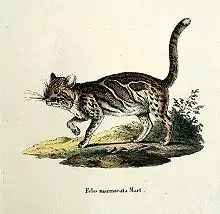
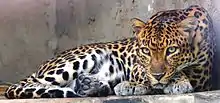
There are over 260 species of carnivorans, the majority of which feed primarily on meat. They have a characteristic skull shape and dentition.
- Suborder: Feliformia
- Family: Felidae (cats)
- Subfamily: Felinae
- Genus: Catopuma
- Genus: Felis
- Jungle cat, F. chaus LC[22]
- Genus: Pardofelis
- Marbled cat, P. marmorata NT[23]
- Genus: Prionailurus
- Leopard cat, P. bengalensis LC[24]
- Subfamily: Pantherinae
- Genus: Neofelis
- Clouded leopard, N. nebulosa VU[25]
- Genus: Panthera
- Leopard, P. pardus VU[26]
- Indochinese leopard, P. p. delacouri possibly extirpated
- Tiger, P. tigris EN[27]
- Leopard, P. pardus VU[26]
- Genus: Neofelis
- Subfamily: Felinae
- Family: Viverridae (civets, mongooses, etc.)
- Subfamily: Paradoxurinae
- Genus: Arctictis
- Genus: Arctogalidia
- Small-toothed palm civet, A. trivirgata LC[29]
- Genus: Paguma
- Masked palm civet, P. larvata LC[30]
- Genus: Paradoxurus
- Asian palm civet, P. hermaphroditus LC[31]
- Subfamily: Hemigalinae
- Genus: Chrotogale
- Owston's palm civet, Chrotogale owstoni EN[32]
- Genus: Chrotogale
- Subfamily: Prionodontinae
- Genus: Prionodon
- Spotted linsang, P. pardicolor LC[33]
- Genus: Prionodon
- Subfamily: Viverrinae
- Genus: Viverra
- Large-spotted civet, V. megaspila LC[34]
- Large Indian civet, V. zibetha LC[35]
- Genus: Viverricula
- Small Indian civet, V. indica LC[36]
- Genus: Viverra
- Subfamily: Paradoxurinae
- Family: Herpestidae (mongooses)
- Genus: Herpestes
- Crab-eating mongoose (Herpestes urva) (Hodgson, 1836) LC[37]
- Genus: Herpestes
- Family: Felidae (cats)
- Suborder: Caniformia
- Family: Canidae (dogs, foxes)
- Family: Ursidae (bears)
- Family: Mustelidae (mustelids)
- Genus: Aonyx
- Asian small-clawed otter, A. cinereus VU[41]
- Genus: Arctonyx
- Hog badger, A. collaris VU[42]
- Genus: Lutra
- Eurasian otter, L. lutra NT[43]
- Hairy-nosed otter, L. sumatrana EN[44]
- Genus: Lutrogale
- Smooth-coated otter, L. perspicillata VU[45]
- Genus: Martes
- Yellow-throated marten, M. flavigula LC[46]
- Genus: Melogale
- Chinese ferret badger, M. moschata LC[47]
- Burmese ferret badger, M. personata LC[48]
- Genus: Mustela
- Yellow-bellied weasel, M. kathiah LC[49]
- Siberian weasel, M. sibirica LC[50]
- Back-striped weasel, M. strigidorsa LC[51]
- Genus: Aonyx
Order: Perissodactyla (odd-toed ungulates)
The odd-toed ungulates are browsing and grazing mammals. They are usually large to very large, and have relatively simple stomachs and a large middle toe.
- Family: Tapiridae (tapirs)
- Genus: Tapirus
- Malayan tapir, T. indicus EN[52]
- Genus: Tapirus
Order: Artiodactyla (even-toed ungulates)

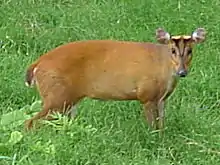
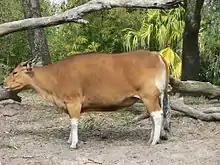
The even-toed ungulates are ungulates whose weight is borne about equally by the third and fourth toes, rather than mostly or entirely by the third as in perissodactyls. There are about 220 artiodactyl species, including many that are of great economic importance to humans.
- Family: Tragulidae
- Genus: Tragulus
- Lesser mouse deer, Tragulus javanicus
- Genus: Tragulus
- Family: Moschidae
- Genus: Moschus
- Dwarf musk deer, Moschus berezovskii
- Genus: Moschus
- Family: Cervidae (deer)
- Subfamily: Cervinae
- Genus: Panolia
- Eld's deer, P. eldii EN[53]
- Genus: Rusa
- Sambar deer, R. unicolor VU[54]
- Genus: Panolia
- Subfamily: Muntiacinae
- Genus: Muntiacus
- Fea's muntjac, M. feae LC
- Indian muntjac, M. muntjak LC[55]
- Truong Son muntjac, M. truongsonensis DD
- Giant muntjac, M. vuquangensis DD
- Genus: Muntiacus
- Subfamily: Cervinae
- Family: Bovidae (cattle, antelope, sheep, goats)
- Subfamily: Bovinae
- Subfamily: Caprinae
- Genus: Capricornis
- Mainland serow, C. sumatraensis VU[58]
- Genus: Nemorhaedus
- Chinese goral, N. caudatus VU[59]
- Genus: Capricornis
- Family: Suidae (pigs)
- Subfamily: Suinae
- Genus: Sus
- Heude's pig, S. bucculentus EX, possibly extant
- Wild boar, S. scrofa LC[60]
- Genus: Sus
- Subfamily: Suinae
Extirpated
The following species are locally extinct in the country:
- Wild water buffalo, Bubalus arnee EN[61]
- Sumatran rhinoceros, Dicerorhinus sumatrensis CR[62]
- Javan rhinoceros, Rhinoceros sondaicus CR[63]
See also
References
- This list is derived from the IUCN Red List which lists species of mammals and includes those mammals that have recently been classified as extinct (since 1500 AD). The taxonomy and naming of the individual species is based on those used in existing Wikipedia articles as of 21 May 2007 and supplemented by the common names and taxonomy from the IUCN, Smithsonian Institution, or University of Michigan where no Wikipedia article was available.
- Choudhury, A.; Lahiri Choudhury, D. K.; Desai, A.; Duckworth, J. W.; Easa, P. S.; Johnsingh, A. J. T.; Fernando, P.; Hedges, S.; Gunawardena, M.; Kurt, F.; Karanth, U; Lister, A.; Menon, V.; Riddle, H.; Rübel, A. & Wikramanayake, E. (2008). "Elephas maximus". IUCN Red List of Threatened Species. 2008: e.T7140A12828813.
- Han, K. H.; Duckworth, J. W. & Molur, S. (2016). "Tupaia belangeri". IUCN Red List of Threatened Species. 2016: e.T41492A22280884.
- Nekaris, K.A.I.; Al-Razi, H.; Blair, M.; Das, J.; Ni, Q.; Samun, E.; Streicher, U.; Xue-long, J. & Yongcheng, L. (2020). "Nycticebus bengalensis". IUCN Red List of Threatened Species. 2020: e.T39758A17970536.
- Nekaris, K.A.I.; Poindexter, S. & Streicher, U. (2020). "Nycticebus coucang". IUCN Red List of Threatened Species. 2020: e.T163017685A17970966.
- Blair, M.; Nadler, T.; Ni, O.; Samun, E.; Streicher, U. & Nekaris, K.A.I. (2020). "Nycticebus pygmaeus". IUCN Red List of Threatened Species. 2020: e.T14941A17971417.
- Chetry, D.; Long, Y.; Htun, S.; Timmins, R.J.; Boonratana, R. & Das, J. (2020). "Macaca arctoides". IUCN Red List of Threatened Species. 2020: e.T12548A17949098.
- Boonratana, R.; Chalise, M.; Htun, S. & Timmins, R. J. (2020). "Macaca assamensis". IUCN Red List of Threatened Species. 2020: e.T12549A17950189.
- Eudey, A.; Kumar, A.; Singh, M. & Boonratana, R. (2020). "Macaca fascicularis". IUCN Red List of Threatened Species. 2020: e.T12551A17949449.
- Timmins, R. J.; Richardson, M.; Chhangani, A. & Yongcheng, L. (2008). "Macaca mulatta". IUCN Red List of Threatened Species. 2008: e.T12554A3356486.
- Boonratana, R.; Ang, A.; Traeholt, C. & Thant, N.M.L. (2020). "Trachypithecus obscurus". IUCN Red List of Threatened Species. 2020: e.T22039A17960562.
- Brockelman, W. & Geissmann, T. (2020). "Hylobates lar". IUCN Red List of Threatened Species. 2020: e.T10548A17967253.
- Lunde, D.; Aplin, K. & Molur, S. (2016). "Hystrix brachyura". IUCN Red List of Threatened Species. 2016: e.T10749A11509929.
- Ruedas, L. (2016). "Rattus norvegicus". IUCN Red List of Threatened Species. 2016: e.T19353A165118026.
- Csorba, G.; Bumrungsri, S.; Bates, P.; Gumal, M.; Kingston, T.; Molur, S. & Srinivasulu, C. (2019). "Cynopterus brachyotis". IUCN Red List of Threatened Species. 2019: e.T6103A22113381.
- Coroiu, I. (2016). "Myotis mystacinus". IUCN Red List of Threatened Species. 2016: e.T14134A22052250.
- Jiang, T.L. & Feng, J. (2020). "Ia io". IUCN Red List of Threatened Species. 2020: e.T10755A21993508.
- Challender, D.; Willcox, D.H.A.; Panjang, E.; Lim, N.; Nash, H.; Heinrich, S. & Chong, J. (2019). "Manis javanica". IUCN Red List of Threatened Species. 2019: e.T12763A123584856.
- Challender, D.; Wu, S.; Kaspal, P.; Khatiwada, A.; Ghose, A.; Ching-Min Su, N. & Laxmi Suwal, T. (2019). "Manis pentadactyla". IUCN Red List of Threatened Species. 2019: e.T12764A123585318.
- Minton, G.; Smith, B. D.; Braulik, G. T.; Kreb, D.; Sutaria, D. & Reeves, R. (2017). "Orcaella brevirostris". IUCN Red List of Threatened Species. 2017: e.T15419A123790805.CS1 maint: multiple names: authors list (link)
- McCarthy, J.; Dahal, S.; Dhendup, T.; Gray, T.N.E.; Mukherjee, S.; Rahman, H.; Riordan, P.; Boontua, N. & Wilcox, D. (2015). "Catopuma temminckii". IUCN Red List of Threatened Species. 2015: e.T4038A97165437.
- Gray, T.N.E.; Timmins, R.J.; Jathana, D.; Duckworth, J.W.; Baral, H. & Mukherjee, S. (2016). "Felis chaus". IUCN Red List of Threatened Species. 2016: e.T8540A50651463.
- Ross, J.; Brodie, J.; Cheyne, S.; Datta, A.; Hearn, A.; Loken, B.; Lynam, A.; McCarthy, J.; Phan, C.; Rasphone, A.; Singh, P.; Wilting, A. (2016). "Pardofelis marmorata". IUCN Red List of Threatened Species. 2016: e.T16218A97164299.
- Ross, J.; Brodie, J.; Cheyne, S.; Hearn, A.; Izawa, M.; Loken, B.; Lynam, A.; McCarthy, J.; Mukherjee, S.; Phan, C.; Rasphone, A. & Wilting, A. (2015). "Prionailurus bengalensis". IUCN Red List of Threatened Species. 2015: e.T18146A50661611.
- Grassman, L.; Lynam, A.; Mohamad, S.; Duckworth, J. W.; Borah, J.; Willcox, D.; Ghimirey, Y.; Reza, A. & Rahman, H. (2016). "Neofelis nebulosa". IUCN Red List of Threatened Species. 2016: e.T14519A97215090.
- Stein, A.B.; Athreya, V.; Gerngross, P.; Balme, G.; Henschel, P.; Karanth, U.; Miquelle, D.; Rostro-Garcia, S.; Kamler, J. F.; Laguardia, A.; Khorozyan, I. & Ghoddousi, A. (2019). "Panthera pardus". IUCN Red List of Threatened Species. 2019: e.T15954A160698029.
- Goodrich, J.; Lynam, A.; Miquelle, D.; Wibisono, H.; Kawanishi, K.; Pattanavibool, A.; Htun, S.; Tempa, T.; Karki, J.; Jhala, Y. & Karanth, U. (2015). "Panthera tigris". IUCN Red List of Threatened Species. 2015: e.T15955A50659951.
- Willcox, D.H.A.; Chutipong, W.; Gray, T.N.E.; Cheyne, S.; Semiadi, G.; Rahman, H.; Coudrat, C.N.Z.; Jennings, A.; Ghimirey, Y.; Ross, J.; Fredriksson, G.; Tilker, A. (2016). "Arctictis binturong". IUCN Red List of Threatened Species. 2016: e.T41690A45217088.
- Willcox, D.H.A.; Duckworth, J.W.; Timmins, R.J.; Chutipong, W.; Choudhury, A.; Roberton, S.; Long, B.; Hearn, A. & Ross, J. (2016). "Arctogalidia trivirgata". IUCN Red List of Threatened Species. 2016: e.T41691A45217378.
- Duckworth, J.W.; Timmins, R.J.; Chutipong, W.; Choudhury, A.; Mathai, J.; Willcox, D.H.A.; Ghimirey, Y.; Chan, B. & Ross, J. (2016). "Paguma larvata". IUCN Red List of Threatened Species. 2016: e.T41692A45217601.
- Duckworth, J.W.; Timmins, R.J.; Choudhury, A.; Chutipong, W.; Willcox, D.H.A.; Mudappa, D.; Rahman, H.; Widmann, P.; Wilting, A. & Xu, W. (2016). "Paradoxurus hermaphroditus". IUCN Red List of Threatened Species. 2016: e.T41693A45217835.
- Timmins, R.J.; Coudrat, C.N.Z.; Duckworth, J.W.; Gray, T.N.E.; Robichaud, W.; Willcox, D.H.A.; Long, B. & Roberton, S. (2016). "Chrotogale owstoni". IUCN Red List of Threatened Species. 2016: e.T4806A45196929.
- Duckworth, J.W.; Lau, M.; Choudhury, A.; Chutipong, W.; Timmins, R.J.; Willcox, D.H.A.; Chan, B.; Long, B. & Roberton, S. (2016). "Prionodon pardicolor". IUCN Red List of Threatened Species. 2016: e.T41706A45219917.
- Timmins, R.; Duckworth, J.W.; WWF-Malaysia; Roberton, S.; Gray, T.N.E.; Willcox, D.H.A.; Chutipong, W. & Long, B. (2016). "Viverra megaspila". IUCN Red List of Threatened Species. 2016: e.T41707A45220097.
- Timmins, R.J.; Duckworth, J.W.; Chutipong, W.; Ghimirey, Y.; Willcox, D.H.A.; Rahman, H.; Long, B. & Choudhury, A. (2016). "Viverra zibetha". IUCN Red List of Threatened Species. 2016: e.T41709A45220429.
- Choudhury, A.; Duckworth, J.W.; Timmins, R.; Chutipong, W.; Willcox, D.H.A.; Rahman, H.; Ghimirey, Y. & Mudappa, D. (2015). "Viverricula indica". IUCN Red List of Threatened Species. 2015: e.T41710A45220632.
- Choudhury, A.; Timmins, R.; Chutipong, W.; Duckworth, J. W.; Mudappa, D. & Willcox, D. H. A. (2015). "Herpestes urva". IUCN Red List of Threatened Species. 2015: e.T41618A86159618.
- Kamler, J. F.; Songsasen, N.; Jenks, K.; Srivathsa, A.; Sheng, L. & Kunkel, K. (2015). "Cuon alpinus". IUCN Red List of Threatened Species. 2015: e.T5953A72477893.
- Scotson, L.; Fredriksson, G.; Augeri, D.; Cheah, C.; Ngoprasert, D. & Wai-Ming, W. (2017). "Helarctos malayanus (errata version published in 2018)". IUCN Red List of Threatened Species. 2017: e.T9760A123798233.
- Garshelis, D. L. & Steinmetz, R. (2016). "Ursus thibetanus". IUCN Red List of Threatened Species. 2016: e.T22824A114252336.
- Wright, L.; de Silva, P.; Chan, B. & Reza Lubis, I. (2015). "Aonyx cinereus". IUCN Red List of Threatened Species. 2015: e.T44166A21939068.
- Duckworth, J.W.; Timmins, R.J.; Chutipong, W.; Gray, T.N.E.; Long, B.; Helgen, K.; Rahman, H.; Choudhury, A. & Willcox, D.H.A. (2016). "Arctonyx collaris". IUCN Red List of Threatened Species. 2016: e.T70205537A45209459.CS1 maint: multiple names: authors list (link)
- Roos, A.; Loy, A.; de Silva, P.; Hajkova, P. & Zemanová, B. (2015). "Lutra lutra". IUCN Red List of Threatened Species. 2015: e.T12419A21935287.
- Aadrean, A.; Kanchanasaka, B.; Heng, S.; Reza Lubis, I.; de Silva, P. & Olsson, A. (2015). "Lutra sumatrana". IUCN Red List of Threatened Species. 2015: e.T12421A21936999.
- de Silva, P.; Khan, W.A.; Kanchanasaka, B.; Reza Lubis, I.; Feeroz, M. M. & Al-Sheikhly, O.F. (2015). "Lutrogale perspicillata". IUCN Red List of Threatened Species. 2015: e.T12427A21934884.
- Chutipong, W.; Duckworth, J.W.; Timmins, R.J.; Choudhury, A.; Abramov, A.V.; Roberton, S.; Long, B.; Rahman, H.; Hearn, A.; Dinets, V. & Willcox, D.H.A. (2016). "Martes flavigula". IUCN Red List of Threatened Species. 2016: e.T41649A45212973.
- Duckworth, J. W.; Abramov, A.V.; Willcox, D.H.A.; Timmins, R.J.; Choudhury, A.; Roberton, S.; Long, B. & Lau, M. (2016). "Melogale moschata". IUCN Red List of Threatened Species. 2016: e.T41626A45209676.
- Duckworth, J.W.; Long, B.; Willcox, D.H.A.; Coudrat, C.N.Z.; Timmins, R.J.; Abramov, A.V.; Chan, B. & Chutipong, W. (2016). "Melogale personata". IUCN Red List of Threatened Species. 2016: e.T41627A45209826.
- Willcox, D.H.A.; Duckworth, J.W.; Timmins, R.J.; Abramov, A.V.; Choudhury, A.; Chutipong, W.; Chan, B.; Lau, M. & Roberton, S. (2016). "Mustela kathiah". IUCN Red List of Threatened Species. 2016: e.T41655A45214014.
- Abramov, A. V.; Duckworth, J. W.; Choudhury, A.; Chutipong, W.; Timmins, R.J.; Ghimirey, Y.; Chan, B. & Dinets, V. (2016). "Mustela sibirica". IUCN Red List of Threatened Species. 2016: e.T41659A45214744.
- Roberton, S.; Duckworth, J. W.; Timmins, R.J.; Abramov, A.; Chutipong, W.; Choudhury, A.; Willcox, D.H.A. & Dinets, V. (2016). "Mustela strigidorsa". IUCN Red List of Threatened Species. 2016: e.T14027A45201218.
- Traeholt, C.; Novarino, W.; bin Saaban, S.; Shwe, N.M.; Lynam, A.; Zainuddin, Z.; Simpson, B. & bin Mohd, S. (2016). "Tapirus indicus". IUCN Red List of Threatened Species. 2016: e.T21472A45173636.
- Gray, T.N.E.; Brook, S.M.; McShea, W.J.; Mahood, S.; Ranjitsingh, M.K.; Miyunt, A.; Hussain, S.A. & Timmins, R.J. (2015). "Rucervus eldii". IUCN Red List of Threatened Species. 2015: e.T4265A22166803.
- Timmins, R.J.; Kawanishi, K.; Giman, B.; Lynam, A.J.; Chan, B.; Steinmetz, R.; Baral, H. S. & Samba Kumar, N. (2015). "Rusa unicolor". IUCN Red List of Threatened Species. 2015: e.T41790A85628124.
- Timmins, R. J.; Duckworth, J. W. & Hedges, S. (2016). "Muntiacus muntjak". IUCN Red List of Threatened Species. 2016: e.T42190A56005589.
- Duckworth, J. W.; Sankar, K.; Williams, A. C.; Samba Kumar, N. & Timmins, R. J. (2016). "Bos gaurus". IUCN Red List of Threatened Species. 2016: e.T2891A46363646.
- Gardner, P.; Hedges, S.; Pudyatmoko, S.; Gray, T.N.E. & Timmins, R.J. (2016). "Bos javanicus". IUCN Red List of Threatened Species. 2016: e.T2888A46362970.
- Phan, T.D.; Nijhawan, S.; Li, S. & Xiao, L. (2020). "Capricornis sumatraensis". IUCN Red List of Threatened Species. 2020: e.T162916735A162916910.
- Bragina, E.; Kim, S.; Zaumyslova, O.; Park, Y.-S. & Lee, W. (2020). "Naemorhedus caudatus". IUCN Red List of Threatened Species. 2020: e.T14295A22150540.
- Keuling, O. & Leus, K. (2019). "Sus scrofa". IUCN Red List of Threatened Species. 2019: e.T41775A44141833.
- Kaul, R.; Williams, A.C.; rithe, k.; Steinmetz, R. & Mishra, R. (2019). "Bubalus arnee". IUCN Red List of Threatened Species. 2019: e.T3129A46364616.
- Ellis, S. & Talukdar, B. (2020). "Dicerorhinus sumatrensis". IUCN Red List of Threatened Species. 2020: e.T6553A18493355.
- Ellis, S. & Talukdar, B. (2020). "Rhinoceros sondaicus". IUCN Red List of Threatened Species. 2020: e.T19495A18493900.
External links
- "Animal Diversity Web". University of Michigan Museum of Zoology. 1995–2006. Retrieved 22 May 2007.

